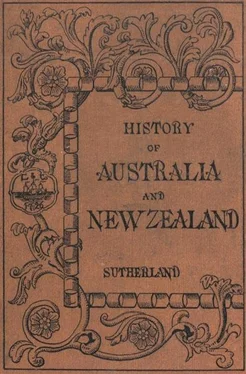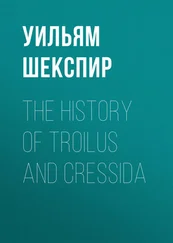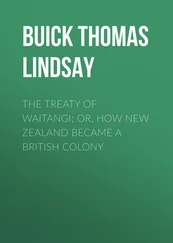9. Insurrection at Ballarat.—Skirmishes between the soldiers and diggers now became frequent; and, on the 30th of November, when the last “digger hunt” took place, the police and soldiers were roughly beaten off. The diggers, among their tents, set up a flagstaff, and hoisted a banner of blue, with four silver stars in the corner. Then the leaders knelt beneath it, and, having sworn to defend one another to the death, proceeded to enrol the miners and form them into squads ready for drilling. Meantime the military camp was being rapidly fortified with trusses of hay, bags of corn, and loads of firewood. The soldiers were in hourly expectation of an attack, and for four successive nights they slept fully accoutred, and with their loaded muskets beside them. All night long lights were seen to move busily backwards and forwards among the diggers’ tents, and the solid tread of great bodies of men could be heard amid the darkness. Lalor was marshalling his forces on the slopes of Ballarat, and drilling them to use such arms as they possessed—whether rifles, or pistols, or merely spikes fastened at the ends of poles.
10. The Eureka Stockade.—Sir Charles Hotham now sent up the remaining eight hundred soldiers of the Ninety-ninth Regiment, under Sir Robert Nickle, and to these he added all the marines from the men-of-war and nearly all the police of the colony. They were several days on the march, and only arrived when the disturbance was over. The diggers had formed an entrenchment, called the Eureka Stockade, and had enclosed about an acre of ground with a high slab fence. In the midst of this stronghold they proclaimed the “Republic of Victoria”; and here they were able to carry on their drilling unmolested, under the command of the two leaders—Vern, a German, and Peter Lalor, the son of an Irish gentleman. They sent out parties in every direction to gather all the arms and ammunition they could obtain, and made extensive preparations for an assault; but, imagining that the soldiers would never dream of attacking them until the arrival of Sir Robert Nickle, they kept guard but carelessly. Captain Thomas—who commanded the troops in the camp—determined to finish the affair by a sudden attack; and, on Saturday night, whilst the diggers were amusing themselves in fancied security, he was carefully making his preparations. On Sunday morning, just after daybreak, when the stockade contained only two hundred men, Captain Thomas led his troops quietly forth, and succeeded in approaching within three hundred yards of the stockade without being observed. The alarm was then given within; the insurgents rushed to their posts, and poured a heavy volley upon the advancing soldiers, of whom about twelve fell. The attacking party wavered a moment, but again became steady, and fired with so calm and correct an aim, that, whenever a digger showed himself, even for a moment, he was shot. Peter Lalor rose on a sand heap within the stockade to direct his men, but immediately fell, pierced in the shoulder by a musket ball. After the firing had lasted for twenty minutes there was a lull; and the insurgents could hear the order “Charge!” ring out clearly. Then there was an ominous rushing sound—the soldiers were for a moment seen above the palisades, and immediately the conflict became hand-to-hand. The diggers took refuge in the empty claims, where some were bayoneted and others captured, whilst the victors set fire to the tents, and soon afterwards retired with 125 prisoners. A number of half-burnt palisades, which had fallen on Lalor, concealed him from view; and, after the departure of the soldiers, he crawled forth, and escaped to the ranges, where a doctor was found, who amputated his arm. The Government subsequently offered a reward of £500 for his capture; but his friends proved true, and preserved him till the trouble was all past.
The number of those who had been wounded was never exactly known, but it was found that twenty-six of the insurgents had died during the fight, or shortly afterwards; and in the evening the soldiers returned and buried such of the dead bodies as were still lying within the stockade. On the following day, four soldiers who had been killed in the engagement were buried with military honours. Many of the wounded died during the course of the following month, and in particular the colony had to lament the loss of Captain Wise, of the Fortieth Regiment, who had received his death wound in the conflict.
11. Trial of the Rioters.—When the news of the struggle and its issue was brought to Melbourne, the sympathies of the people were powerfully roused in favour of the diggers. A meeting, attended by about five thousand persons, was held near Prince’s Bridge, and a motion, proposed by Mr. David Blair, in favour of the diggers, was carried almost unanimously. Similar meetings were held at Geelong and Sandhurst, so that there could be no doubt as to the general feeling against the Government; and when, at the beginning of 1855, thirteen of the prisoners were brought up for trial in Melbourne, and each in his turn was acquitted, crowds of people, both within and without the courts, greeted them, one after another, with hearty cheers as they stepped out into the open air, once more free men.
12. Improvements on the Goldfields.—The commission appointed by Sir Charles Hotham commenced its labours shortly after the conclusion of the riot, and in its report the fact was clearly demonstrated that the miners had suffered certain grievances. Acting upon the advice of this commission, the Legislative Council abolished the monthly fee, and authorised the issue of “Miners’ Rights,” giving to the holders, on payment of one pound each per annum, permission to dig for gold in any part of the colony. New members were to be elected to the Council, in order to watch over the interests of the miners, two to represent Sandhurst, two for Ballarat, two for Castlemaine, and one each for the Ovens and the Avoca Diggings. Any man who held a “Miner’s Right” was thereby qualified to vote in the elections for the Council.
These were very just and desirable reforms, and the Government added to the general satisfaction by appointing the most prominent of the diggers to be justices of the peace on the goldfields. Thus the colony very rapidly returned to its former state of peaceful progress, and the goldfields were soon distinguished for their orderly and industrious appearance.
CHAPTER XIV.
NEW SOUTH WALES, 1851-1860.
1. Effects of Gold Discovery.—For some years after 1851 the colony of New South Wales passed through a severe ordeal. The separation of Port Phillip had reduced her population by one-fourth and decreased her wealth by fully a third; the discoveries of gold at Ballarat and Bendigo had deprived her of many of her most desirable colonists. But the resources of the colony were too vast to allow of more than a merely temporary check, and, after a year or two, her progress was steady and marked. The gloomy anticipations with which the gold discoveries had been regarded by the squatters and employers of labour were by no means realised; for though men were for a time scarce, and wages exceedingly high, yet, when the real nature of a gold-digger’s life and the meagreness of the average earnings became apparent, the great majority of the miners returned to their ordinary employments and the colony resumed its former career of steady progress, though with this difference, that the population was greater, and business consequently brisker than it had ever been before.
Fortune, however, had given to Victoria so great an impetus in 1851, that the firm prosperity of New South Wales was completely lost sight of in the brilliant success of its younger neighbour. The yield of gold in New South Wales was never great as compared with that of Victoria; for, with the exception of 1852, no year produced more than two million pounds worth. But the older colony learnt more and more to utilise its immense area in the growth of wool, an industry which yielded greater and more permanent wealth than has ever been gained from gold mining.
Читать дальше












